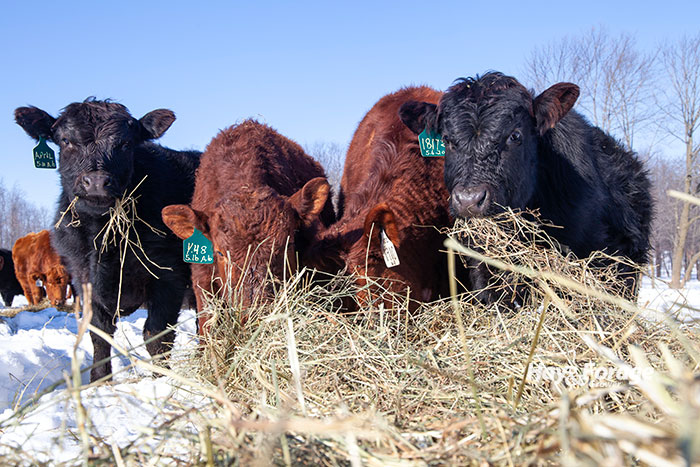
The holidays, which offer a brief but welcomed distraction to winter feeding chores, have come and gone. For many during the past two weeks, we’ve experienced seasonal weather, followed by snow and frigid air, followed by unseasonably balmy temperatures. Winter, like no other season, offers up snow, ice, sleet, rain, mud, frozen ground, cold, wind, and far less frequently . . . relief from all of the above.
It’s sometimes easy to overlook what’s really going on with the cows and their feed when icicles dangle from your ear lobes or mud relentlessly reaches from the depths to grab the boots off your feet. Winter chores are a survival game but don’t lose sight of what’s going on during the hay-feeding ritual.
Waste is a waste
Too often in our feeding systems, we accept waste as a cost of doing business. Perhaps that is true, but it’s a cost that can and should be controlled. How hay gets fed makes a big difference in controlling waste. Yes, pasture-fed hay that is wasted will contribute to enhanced soil fertility, but that’s of little consequence if you’re short on hay. Cows don’t eat soil.
Large round bale feeding systems are designed to save time and labor but not necessarily waste. Research from Nebraska and Michigan State universities demonstrates the impact of hay-feeder type on the amount of feed loss. As also documented in other studies, the tapered cone feeder often results in the least amount of hay waste (less than 5%). The next best option is a ring feeder with a bottom skirt.
Long, rectangular feeders are less effective at reducing hay waste compared to round or square feeders because boss animals can more easily push others away from the feeder.
Bale density also makes a difference. Research at the University of Arkansas showed hay loss was four to five times less in a tapered cone feeder when dense alfalfa-grass hay was fed compared to less-dense oat hay. In this comparison, feed quality may also have been a contributing factor to greater feed loss for the oat hay; livestock will eat more and waste less of high-quality hay compared to low-quality hay, regardless of the feeding method.
Farmers that have shifted from dry hay to baleage generally find that the higher moisture feed generally results in less waste.
Feeding frequency also impacts feed loss. During these dog days of winter, it might be tempting to put out enough hay for multiple days, but daily feeding will force cattle to eat hay they might otherwise refuse, overconsume, trample, and waste. Cattle waste less hay when the amount fed is limited to what is needed each day. Limit feeding is a proven hay conservation strategy, but it does require additional time and effort.
Frozen wrap and twine
One of the tasks associated with bale feeding is the removal of the bale-binding material, be it net wrap, plastic twine, or sisal twine. But what if you don’t get it all off and the cattle consume it?
During winter, the binding type of choice often freezes to the bale, making removal a more difficult and time-consuming task.
In a study conducted at North Dakota State University, where plenty of expertise exists on anything frozen, researchers examined the digestibility of three types of net wrap, biodegradable twine, and sisal twine.
Using Holstein steers, they cut the binding materials into 2-millimeter lengths, placed them in Dacron bags, and put them in an animal’s rumen for 14 days. Seventy percent of the sisal twine was digested within the two-week period, but virtually none of the net wrap or biodegradable twine had disappeared based on measured weight in and weight out. Several follow-up studies have demonstrated similar results.
The lesson gained from this research is that the removal of all binding material is a safe play, regardless of the weather. Net wrap and twine have been known to build up in the rumen over time and cause digestive issues.
Test and monitor
Unknown forage quality yields unknown and sometimes disastrous livestock performance.
Forage test results are indispensable for determining a feed’s best and most economical use in a ration. Working from an accurate forage test, hay can be matched to livestock needs based on the type of animals being fed. It also enables for the most efficient purchase and use of supplements.
Body condition is more difficult to maintain in winter because additional nutrients are directed toward animal maintenance. Winter hay feeding becomes an exercise in matching livestock to hay quality and closely monitoring performance and body condition, even if from the front seat of the pickup while your body parts are in thaw mode.
Stay positive. The days are getting longer.

